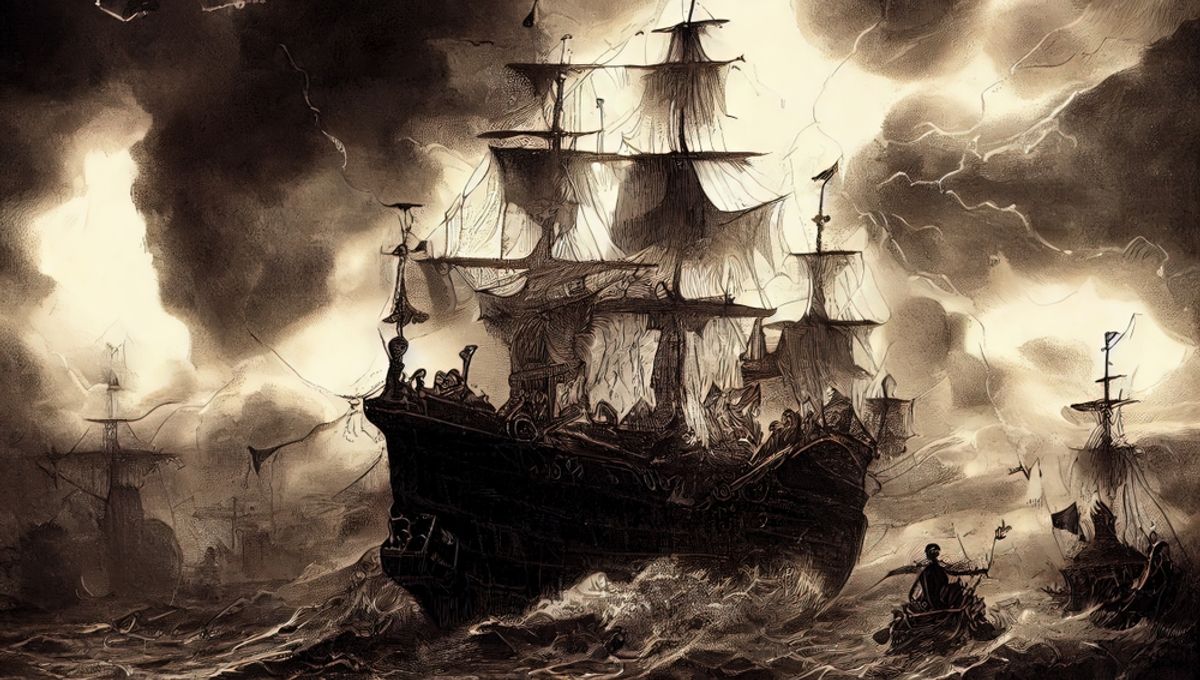
On August 11, 1775, lookouts on the whaling vessel Herald spotted something strange in the waters off the coast of Greenland. A three-masted schooner, named the Octavius, seemingly sparkling with ice and snow, was drifting towards them – with no crew in sight.
Accompanied by four of his men, the Herald’s captain, Warren, boarded the mysterious ship to investigate. What they found was the stuff of horror stories: 28 dead seamen, huddling in their bunks as if to protect themselves from the cold; a woman and child, perfectly preserved together; a sailor, forever frozen in a futile attempt to build a fire on the deck. And, in the captain’s quarters, the master of the ship – still sitting at his desk, writing his last journal entry for this doomed voyage.
It was dated November 11, 1762. The crew had been dead for 13 years.
Most intriguing of all, though, was the last recorded location of the ship: 75°N 160°W, about 402 kilometers (250 miles) north of the place we now know as Utqiagvik, Alaska. The Octavius, it seemed, had done the impossible: it had successfully navigated across the Northwest Passage, nearly a century before any other ship would do the same. And it had done so without a single living soul on board.
At least, so the legend goes. But is there any truth to this tale? Or is it just another ghost story, like Davy Jones or the Flying Dutchman before it, told to frighten the young and impressionable away from the cruel and capricious sea?
The boring truth is, it’s almost certainly nothing more than legend. The earliest reference to the Octavius seems to come from around 1828, more than half a century after its supposed discovery, in the American literary gazette The Ariel.
Yet earlier versions can be found, with the ship renamed the Gloriana, or even given no name at all, and the ship’s journey transported from the Northwest Passage to the Baltic Sea. Later retellings have the ship christened The Jenny, and her fate sealed on the other side of the planet entirely – but all other details remain the same. In other words, it always was just a sailors’ ghost story.
But the 19th and 20th centuries’ fascination with ghost ships, languidly haunting the edges of the planet in search of a doomed mission, didn’t come from nowhere – and there are one or two cases from history where so-called “ghost ships” turned out to be as real as you and me.
Take, for example, the aptly-named HMS Terror. This, too, was a ship that seemingly vanished during an ill-fated search for the Northwest Passage, taking with it more than 120 lives and its sister ship, the HMS Erebus.
As the icy seas froze around the ships, they became stuck fast, and the crew abandoned ship in the hopes of walking south to safety. But with only poor-quality rations to sustain them, and thousands of kilometers of frozen wasteland between them and their rescue, they all died. Subsequent search parties found only their skeletons, and diaries recording their demise.
Originally wrecked by the Arctic weather in 1848, the Erebus and the Terror became the subjects of one of the world’s greatest maritime mysteries until their eventual discoveries in 2014 and 2016, respectively. Like the Octavius, the ships were seemingly frozen in time: the Terror was in such pristine condition, Arctic Research Foundation spokesman Adrian Schimnowski told CNN at the time, that “if you could lift [it] out of the water, and pump the water out, it would probably float.”
Then there’s the SS Baychimo, a ghost ship with the distinction of having actual photographic evidence supporting it. After nearly two decades of successful navigation around the Arctic oceans, the ship was surprised by a blizzard at the Sea Horse Islands, not far from where the Octavius supposedly recorded her last location. Again, the crew and passengers abandoned ship – some were taken to Alaska and Vancouver, while a few crew members overwintered nearby until the ship was ready to start moving again.
But in November of that year, another storm hit. When it cleared, the Baychimo was gone.
“The captain and crew assumed the vessel had sunk,” explained Cortney Pachet, Collections Registration Associate at the Manitoba Museum back in 2020. “But they soon received word that an Inuk hunter had spotted the Baychimo, once again packed in ice, roughly 72 km south of their encampment.”
The crew tracked down the ship once again, recovered anything valuable still on board, and abandoned her to the ice. But that wouldn’t be the last of the Baychimo: between that point and 1969, the crewless ship would be seen sailing through the Arctic seas at least seven times, with some onlookers even boarding the mysterious ship.
The SS Baychimo has not been seen in more than 50 years now, but that hasn’t stopped people from looking for her – along with the estimated 4,000 other ships wrecked along the Arctic coast. And while she’s most likely ended up, like so many before her, on the bottom of the ocean by now, one thing’s for sure: if HMS Terror can turn up after nearly 170 years under the icy depths, maybe SS Baychimo stands a chance too.
Source Link: Are “Ghost Ships” Really Traveling The World’s Oceans With No One Aboard To Crew Them?